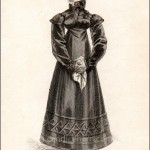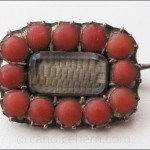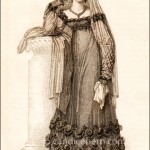 Ackermann’s Repository of Arts, September 1809
Ackermann’s Repository of Arts, September 1809
“Mourning Dresses”
This first year of publication of the Repository of Arts including many fashion prints of women with children. This is the only one I’ve seen of a child in mourning dress. There was no prescribed public mourning for any member of the royal family at this time, so this print represents a more general, personal mourning. As the country was at war with France, there would have been many occasions for ladies to don black.
The description of this print is most interesting as it explains how this particular dress could be modified for deep mourning. Deep or full mourning would not have allowed white trimmings and accessories, but required unrelieved black. This dress represent what was known as slight mourning, or sometimes as second mourning. Fabrics for both deep and slight mourning were meant to have no shine or sheen, but to be somber and flat. The next stage of mourning following slight mourning was half mourning, when fabrics could have a slight sheen, and greys and lilacs were introduced.
Here is the text accompanying the print in the magazine:
“As many of our discerning and tasteful correspondents have hinted to us the utility of occasionally presenting them with a mourning, we take advantage of the present period to comply with their wishes. Fashion and novelty seem at this moment to require from their votaries a cessation from their general labours, and individual taste and invention are left to sport at pleasure in that elegant simplicity of attire which at this season takes place, of the splendid decoration which distinguishes the more brilliant parties of the metropolis.
“Our plate will be found to represent a lady and her infant in slight mourning habits: the former composed of black gossamer net, or imperial gauze, worn over a white satin slip. A demi-traine. A round frock front, and short French sleeves, each edged with a rich Vandyke lace. A cestus of white satin, edged with gold bullion, finished in front with a rich cord and cone tassels, suspended from topaz studs. Pearl necklace and bracelets, with topaz snaps. Hair in the eastern style, with a Spartan diadem, and comb of topaz or gold. A Circassian scarf of grey Spanish silk, with a Tuscan border in black embroidery, and tassels to correspond; confined on one shoulder with a topaz broach. Shoes of grey satin, with clasps of jet, or rosettes of black bugles. White gloves of French kid; and fan of black crape, with gold spangled devices.
“In deep mourning, this robe should be formed of black crape, and worn over black sarsnet. The ornaments and trimmings of every description must be of bugles or jet. The shoes of queen’s silk. The scarf, black crape or imperial silk, spotted and bordered with bugles. Jet tassels and broach.
“The child’s dress is a simple frock of black crape muslin, tucked small, and worn over a cambric skirt. A plain net-lace tucker, and cap en suite. Grey kid slippers, with black clasps.”







